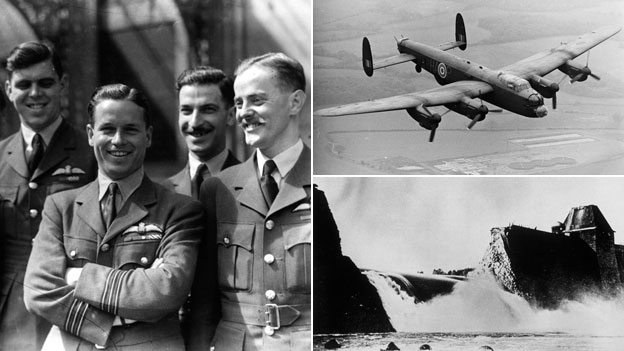All of we Brits of a certain age remember the film. Richard Todd coolly leading his elite squadron of Lancaster bombers into attack the Mohne, Eder, and Sorpe dams. British stiff-upper lip and brilliant “bouncing bomb” technology combining against the backdrop of a stirring but peculiarly 1950s soundtrack to deal the Nazis a crippling blow. Seventy years ago today the Dambusters of 617 Squadron undertook the actual “dams raid” and in spite of many politically correct attempts to ‘revise’ history, the attack remains one of the most stunning precision air strikes in military history.
The facts alone speak for themselves. Twenty-four-year-old Wing Commander Guy Gibson VC, DSO (Bar), DFC (Bar), RAF, a veteran of over 170 missions, led the nineteen Lancaster Mark IIIs in his bomber G for George. His ‘Lancs’ were armed with Professor Barnes Wallace’s amazing Upkeep ‘mine’which was designed to bounce across the lakes behind the German dams before rolling down the dam face and exploding. Upkeep had been inspired by pebbles skipping across a pond.
Early in the morning of 17 May the Mohne and Eder dams were breached and water catastrophically-flooded the Ruhr and Eder valleys. Some 1600 people were killed and many factories were destroyed or damaged together with two hydro-electric plants. Of the 133 airmen who took part in the raid 53 were killed. This was World War Two – total war.
Strangely the raid has touched me personally. A couple of years ago I had the honor to visit 617 “Dambusters” Squadron at RAF Lossiemouth in Scotland. Not only do I have a picture of me posing (no other word for it) in a 617 Squadron Tornado fighter-bomber but I recall the fascinating squadron museum. Ironically, seventy years ago had I been sitting at this seat at around 0030 hours the 9 aircraft of Formation One would have roared over my house no more than 25 meters (80 feet) above my head. The Dambusters flew over Alphen en route to the dams and the whole village was awakened by the low-flying cacophony of 36 Rolls-Royce Merlin engines.
Furthermore, Formation Three was comprised of two Lancasters which formed a mobile reserve one of which (S for Sugar) was shot up by German flak over Molenschot some five kilometers from here and then crashed onto the German airbase at Gilze-Rijen just up the road. Earlier this year my wife and I visited the graves of Pilot Officer Lewis and his crew which are interred in the Bergen-op-Zoom British-Canadian Commonwealth War Grave.
Although not connected with the dams raid three weeks ago my wife and I had the very real pleasure of lunch with Group Captain Steve Reeves and his wife Michelle at RAF Leeming. This was following our discovery of another crash site close to our house where a Royal Canadian Air Force Halifax II (JD363) of 429 Squadron RCAF had crashed. Piloted by Flight Sergeant Graham Howard the Halifax had crashed in October 1943 with the loss of all seven members of its Canadian and British crew. The site at Bolk, Belgium has been both marked and preserved by local people and my wife and I had the honor to present my wife’s photograph of the monument to Group Captain Reeves at RAF Leeming. What moved me to take this photograph back to Leeming was the fact that last year I had the honor to address senior RAF personnel at the base (and fly an RAF aircraft – yes, really!). Movingly, I ate my meals in the same mess (dining room) as the men of JD363 shortly before they left on their final mission.
So what was the impact of the dams raid? There have been many attempts to downplay it. Certainly, the Germans moved quickly to repair the damage and by the following September the lakes were once again filling, although the dams never achieved full capacity until the following year. However, slave labor had to be diverted from the building of the Atlantic Wall and this meant that by June 1944 and D-Day the defenses were weaker than they would have been. Moreover, the British had proven they could undertake precision strike missions and armed with new bombs designed by Barnes Wallace ‘617’ went onto destroy critical bridges and tunnels before sinking the German battleship Tirpitz.
Time of course moves on and this week I had the honor of leading a NATO-backed meeting at Wilton Park with my friends from the German armed forces, including the Luftwaffe. That of course is the most important historical twist and I am sure the men of 617 Squadron would have heartily approved.
Julian Lindley-French is a member of the Atlantic Council’s Strategic Advisory Group. This essay first appeared on his personal blog, Lindley-French’s Blog Blast.
Photo credit: BBC
Image: dambusters.jpg

